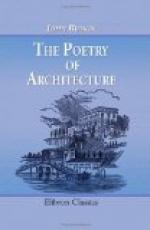164. It is thus that taste is the child and the slave of memory; and beauty is tested, not by any fixed standard, but by the chances of association; so that in every domestic building evidence will be found of the kind of life through which its owner has passed, in the operation of the habits of mind which that life has induced. From the superannuated coxswain, who plants his old ship’s figure-head in his six square feet of front garden at Bermondsey, to the retired noble, the proud portal of whose mansion is surmounted by the broad shield and the crested gryphon, we are all guided, in our purest conceptions, our most ideal pursuit, of the beautiful, by remembrances of active occupation; and by principles derived from industry regulate the fancies of our repose.
165. It would be excessively interesting to follow out the investigation of this subject more fully, and to show how the most refined pleasures, the most delicate perceptions, of the creature who has been appointed to eat bread by the sweat of his brow, are dependent upon, and intimately connected with, his hours of labor. This question, however, has no relation to our immediate object, and we only allude to it, that we may be able to distinguish between the two component parts of individual character; the one being the consequence of continuous habits of life acting upon natural temperament and disposition, the other being the humor of character, consequent upon circumstances altogether accidental, taking stern effect upon feelings previously determined by the first part of the character; laying on, as it were, the finishing touches, and occasioning the innumerable prejudices, fancies, and eccentricities, which, modified in every individual to an infinite extent, form the visible veil of the human heart.
166. Now, we have defined the province of the architect to be, that of selecting such forms and colors as shall delight the mind, by preparing it for the operations to which it is to be subjected in the building. Now, no forms, in domestic architecture, can thus prepare it more distinctly than those which correspond closely with the first, that is, the fixed and fundamental, part of character, which is always so uniform in its action, as to induce great simplicity in whatever it designs. Nothing, on the contrary, can be more injurious than the slightest influence of the humors upon the edifice; for the influence of what is fitful in its energy, and petty in its imagination, would destroy all the harmony of parts, all the majesty of the whole; would substitute singularity for beauty, amusement for delight, and surprise for veneration. We could name several instances of buildings erected by men of the highest talent, and the most perfect general taste, who yet, not having paid much attention to the first principles of architecture, permitted the humor of their disposition to prevail over the majesty of their intellect, and, instead of building from a fixed design, gratified freak after freak, and fancy after fancy, as they were caught by the dream or the desire; mixed mimicries of incongruous reality with incorporations of undisciplined ideal; awakened every variety of contending feeling and unconnected memory; consummated confusion of form by trickery of detail; and have left barbarism, where half the world will look for loveliness.




